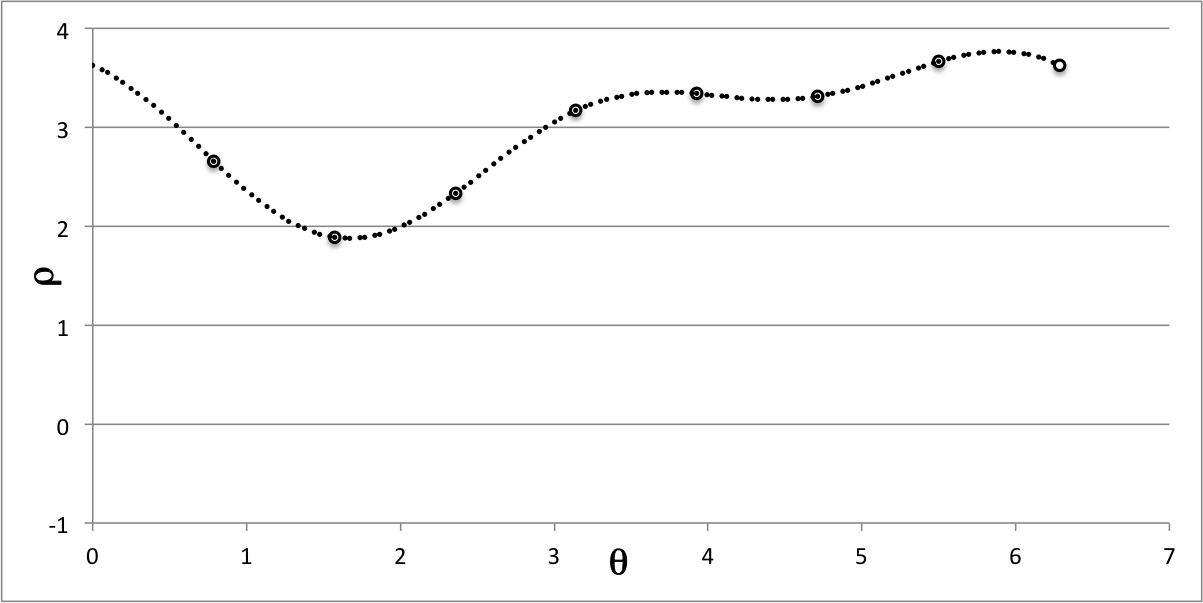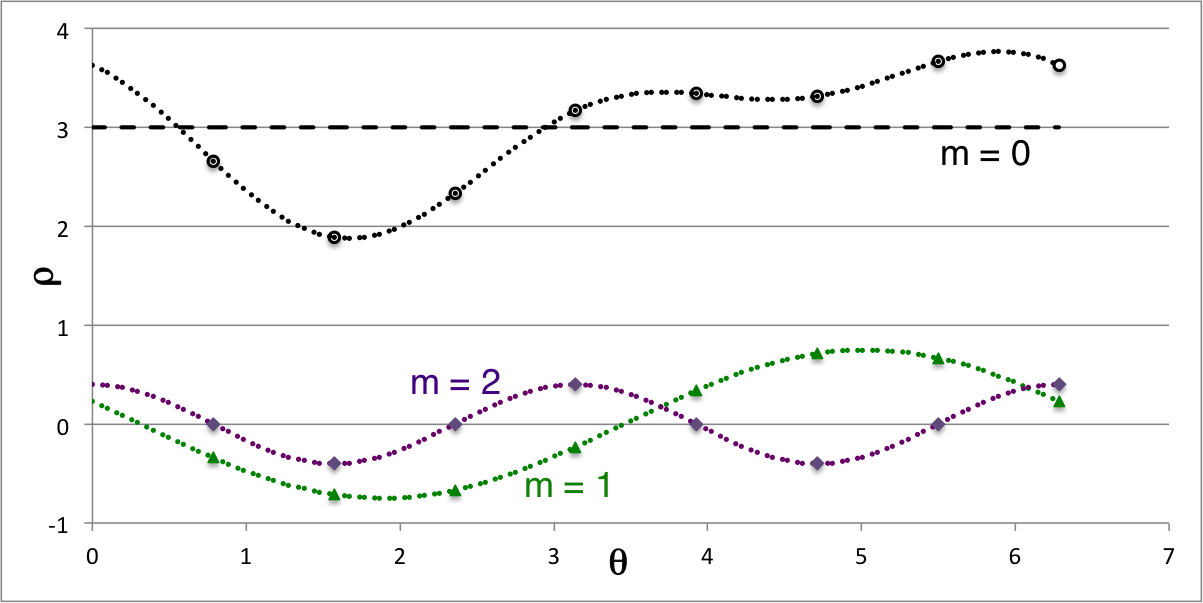Difference between revisions of "User:Tohline/Appendix/Ramblings/FourierSeries"
| Line 697: | Line 697: | ||
</tr> | </tr> | ||
</table> | </table> | ||
Alternatively, we can switch from the Fourier series coefficients, <math>~a_m</math> and <math>~b_m</math>, to the coefficient/phase definitions, <math>~c_m</math> and <math>~\phi_m</math>, such that, | Alternatively, we can switch from the Fourier series coefficients, <math>~a_m</math> and <math>~b_m</math>, to the coefficient/phase definitions, <math>~c_m</math> and <math>~\phi_m</math>, such that, | ||
| Line 755: | Line 756: | ||
</table> | </table> | ||
</div> | </div> | ||
<table border="1" align="center" cellpadding="5"> | |||
<tr> | |||
<td align="center"><math>~m</math></td> | |||
<td align="center"><math>~a_m</math></td> | |||
<td align="center"><math>~b_m</math></td> | |||
<td align="center"><math>~c_m</math></td> | |||
<td align="center"><math>~\phi_m</math></td> | |||
</tr> | |||
<tr> | |||
<td align="center"><math>~0</math></td> | |||
<td align="center"><math>~6</math></td> | |||
<td align="center"><math>~0</math></td> | |||
<td align="center"><math>~6</math></td> | |||
<td align="center"><math>~0</math></td> | |||
</tr> | |||
<tr> | |||
<td align="center"><math>~1</math></td> | |||
<td align="center"><math>~0.2318</math></td> | |||
<td align="center"><math>~-0.7133</math></td> | |||
<td align="center"><math>~0.7500</math></td> | |||
<td align="center"><math>~0.4\pi</math></td> | |||
</tr> | |||
</table> | |||
Notice that, when <math>~a_m = 0</math>, <math>~\tan^{-1}(-b_m/a_m) = \pi/2</math>. Using <math>~c_m</math> and <math>~\phi_m</math>, the discrete density distribution can be exactly reconstructed via the Fourier series, | Notice that, when <math>~a_m = 0</math>, <math>~\tan^{-1}(-b_m/a_m) = \pi/2</math>. Using <math>~c_m</math> and <math>~\phi_m</math>, the discrete density distribution can be exactly reconstructed via the Fourier series, | ||
<div align="center"> | <div align="center"> | ||
| Line 761: | Line 787: | ||
<tr> | <tr> | ||
<td align="right"> | <td align="right"> | ||
<math>~\rho(\ | <math>~\rho(\theta_L)</math> | ||
</td> | </td> | ||
<td align="center"> | <td align="center"> | ||
| Line 768: | Line 794: | ||
<td align="left"> | <td align="left"> | ||
<math>~ | <math>~ | ||
\frac{c_0}{2} + \ | \frac{c_0}{2} + \sum_{m=1}^{L_\mathrm{max}/2} c_m \cos\biggl[m\theta_L + \phi_m\biggr] \, . | ||
</math> | </math> | ||
</td> | </td> | ||
Revision as of 17:50, 30 November 2017
Fourier Series

|
|---|
| | Tiled Menu | Tables of Content | Banner Video | Tohline Home Page | |
Representations
The following Fourier series representations have been drawn primarily from pp. 458 - 460 of the 1971 (19th) edition of the CRC's Standard Mathematical Tables, published by the Chemical Rubber Co., Cleveland, Ohio, U.S.A.
Standard
If <math>~f(x)</math> is a bounded periodic function of period <math>~2L</math>, it may be represented by the Fourier series,
| Standard Fourier Series Expression | |||
|---|---|---|---|
|
where,
|
<math>~a_n</math> |
<math>~=</math> |
<math>~ \frac{1}{L} \int_{-L}^{L} f(x) \cos\biggl( \frac{n\pi x}{L} \biggr) dx </math> |
for | <math>~n = 0, 1, 2, 3, \dots \, ;</math> | |
|
<math>~b_n</math> |
<math>~=</math> |
<math>~ \frac{1}{L} \int_{-L}^{L} f(x) \sin\biggl( \frac{n\pi x}{L} \biggr) dx </math> |
for | <math>~n = 1, 2, 3, \dots </math> |
Alternate
Alternatively, if we set <math>~a_n = c_n \cos\phi_n</math> and <math>~b_n = - c_n \sin\phi_n</math>, then,
|
<math>~a_n\cos \biggl(\frac{n\pi x}{L}\biggr) + b_n\sin \biggl(\frac{n\pi x}{L}\biggr) </math> |
<math>~=</math> |
<math>~ c_n \cos\phi_n \cos \biggl(\frac{n\pi x}{L}\biggr) - c_n \sin\phi_n \sin \biggl(\frac{n\pi x}{L}\biggr) </math> |
|
|
<math>~=</math> |
<math>~ c_n \cos \biggl(\frac{n\pi x}{L} + \phi_n \biggr) \, , </math> |
in which case we may rewrite the Fourier series expression in the form,
| Alternate Fourier Series Expression | |||
|---|---|---|---|
|
where,
|
<math>~c_n = \sqrt{a_n^2 + b_n^2}</math> |
and |
<math>~\phi_n = \tan^{-1}\biggl(\frac{-b_n}{a_n}\biggr) \, .</math> |
Complex
Here we make use of the exponential/complex relation — also referred to as Euler's equation,
<math>~e^{i\alpha} = \cos\alpha + i \sin\alpha \, ,</math> <math>~\Rightarrow</math> <math>~e^{-i\alpha} = \cos\alpha - i \sin\alpha \, ,</math>
in which case we may write,
|
<math>~\cos\alpha = \frac{1}{2} \biggl[ e^{i\alpha} + e^{-i\alpha}\biggr] \, ,</math> |
and |
<math>~\sin\alpha = \frac{1}{2i} \biggl[ e^{i\alpha} - e^{-i\alpha}\biggr]\, .</math> |
Employing these definitions of the trigonometric relations <math>~\cos\alpha</math> and <math>~\sin\alpha</math>, the standard representation of the Fourier series may be rewritten as,
| Complex Fourier Series Expression | |||
|---|---|---|---|
|
where, for <math>~n = 0, \pm 1, \pm 2, \pm 3, \dots~</math>,
|
<math>~\omega_n</math> |
<math>~=</math> |
<math>~ \frac{n\pi }{L} \, , </math> |
and the complex coefficients,
|
<math>~d_n = a_{n} -i b_{n} </math> |
<math>~=</math> |
<math>~ \frac{1}{L} \int_{-L}^{L} f(x) \cos\biggl( \frac{n\pi x}{L} \biggr) dx - i\frac{1}{L} \int_{-L}^{L} f(x) \sin\biggl( \frac{n\pi x}{L} \biggr) dx </math> |
|
|
<math>~=</math> |
<math>~ \frac{1}{L} \int_{-L}^{L} f(x) \biggl[ \cos\biggl( \frac{n\pi x}{L} \biggr) - i\sin\biggl( \frac{n\pi x}{L} \biggr)\biggr] dx </math> |
|
|
<math>~=</math> |
<math>~ \frac{1}{L} \int_{-L}^{L} f(x)e^{-i\omega_n x} dx \, . </math> |
Let's demonstrate that this rewritten (complex) expression for <math>~f(x)</math> matches the standard Fourier series expression. First, we will refer to the above standard definitions of <math>~a_n</math> and <math>~b_n</math> as, respectively, <math>~a_{|n|}</math> and <math>~b_{|n|}</math>, and recognize that, as the summation is extended to negative numbers, the following mapping is appropriate:
|
<math>~a_n ~ \rightarrow ~ a_{|n|}</math> |
and |
<math>~b_n ~ \rightarrow ~ b_{|n|} \, ,</math> |
for | <math>~n > 0 \, ;</math> |
|
<math>~a_n ~ \rightarrow ~ a_{|n|}</math> |
and |
<math>~b_n ~ \rightarrow ~ - b_{|n|} \, ,</math> |
for | <math>~n < 0 \, .</math> |
Hence, we have,
|
<math>~2f(x)</math> |
<math>~=</math> |
<math>~ \sum_{n = -\infty}^{n = + \infty} (a_n - ib_n)e^{i\omega_n x} </math> |
|
|
<math>~=</math> |
<math>~ \sum_{n = 1}^{n = + \infty} (a_{|n|} - ib_{|n|})e^{i\omega_{|n|} x} + a_0 + \sum_{n = \infty}^{n = 1} (a_{|n|} + ib_{|n|})e^{- i\omega_{|n|} x} </math> |
|
|
<math>~=</math> |
<math>~ \sum_{n = 1}^{n = + \infty} (a_{|n|} - ib_{|n|}) [ \cos (\omega_{|n|} x) + i\sin (\omega_{|n|} x)] + a_0 + \sum_{n = 1}^{n = \infty} (a_{|n|} + ib_{|n|}) [ \cos (\omega_{|n|} x) - i\sin (\omega_{|n|} x)] </math> |
|
|
<math>~=</math> |
<math>~ a_0 + \sum_{n = 1}^{n = + \infty}\biggl\{ (a_{|n|} - ib_{|n|}) [ \cos (\omega_{|n|} x) + i\sin (\omega_{|n|} x)] + (a_{|n|} + ib_{|n|}) [ \cos (\omega_{|n|} x) - i\sin (\omega_{|n|} x)] \biggr\} </math> |
|
|
<math>~=</math> |
<math>~ a_0 + \sum_{n = 1}^{n = + \infty}\biggl\{2a_{|n|} \cos (\omega_{|n|} x) + 2b_{|n|} \sin (\omega_{|n|} x)] \biggr\} </math> |
|
<math>~\Rightarrow ~~~ f(x)</math> |
<math>~=</math> |
<math>~ \frac{a_0}{2} + \sum_{n = 1}^{n = + \infty}\biggl\{a_{|n|} \cos (\omega_{|n|} x) + b_{|n|} \sin (\omega_{|n|} x)] \biggr\} \, . </math> |
Q.E.D.
From Williams & Tohline (1987)
Here, we replicate the discussion of a Fourier series analysis that was presented by H. A. Williams & J. E. Tohline (1987, ApJ, 315, 594) — see especially their §III — in the context of their discussion of nonlinear dynamic instabilities in rotating polytropes.
A useful way of analyzing the growth and pattern speed of nonaxisymmetric structures is to Fourier transform the (discrete) density distribution, <math>~\rho(\theta_L)</math>, in angle space, <math>~\theta_L = L \delta\theta</math>, where, <math>~\delta\theta \equiv 2\pi/L_\mathrm{max}</math>. On the discrete angular grid, the Fourier transform equations are
|
<math>~a_m</math> |
<math>~=</math> |
<math>~ \frac{2}{L_\mathrm{max}} \cdot \sum_{L=1}^{L_\mathrm{max}} \rho(\theta_L) \cos(m\theta_L) \, , </math> |
|
<math>~b_m</math> |
<math>~=</math> |
<math>~ \frac{2}{L_\mathrm{max}} \cdot \sum_{L=1}^{L_\mathrm{max}} \rho(\theta_L) \sin(m\theta_L) \, . </math> |
Notice that, <math>~a_0 = 2\bar\rho</math>, where <math>~\bar\rho</math> is the average density. The density function can be reconstructed via the expression,
|
<math>~\rho(\theta_L)</math> |
<math>~=</math> |
<math>~ \frac{a_0}{2} + \sum_{m=1}^{L_\mathrm{max}/2} \biggl[ a_m \cos(m\theta_L) + b_m\sin(m\theta_L) \biggr] \, . </math> |
|
Suppose the density distribution is given by the expression,
|
||||||||||||||||||||||||||||||||||||||||||||||||||||||||||||||||||||||||||||||||||||||||||||||||||||||||||||||||||||
|
Example #1: Suppose <math>~\bar\rho = 3</math>; <math>~(j, k, L_\mathrm{max}) = (1, 2, 8)</math>; and,
In this case, the specified density distribution is given by the expression, <math>~\rho_i = 3 + \tfrac{3}{4}\sin(\theta + 0.9\pi) + \tfrac{2}{5}\cos(2\theta) \, . </math> Figure 1a displays the behavior of this <math>~\rho_i(\theta)</math> function over the interval, <math>~0 < \theta \le 2\pi</math>; the eight circular markers that are located at equally spaced intervals across this angular domain identify the eight discrete values of <math>~\rho_i(\theta_L)</math> that have been listed in the third column of Table 1.
The eight discrete values of <math>~\rho_i</math> and corresponding values of <math>~\theta_L</math> that have been listed in columns 3 and 2, respectively, of Table 1, have been used to determine the <math>~a_m</math> and <math>~b_m</math> coefficient values that have been listed in columns 5 and 6, respectively, of Table 1. The density reconstruction — see the last column (column 7) of Table 1 — is obtained via the expression,
In addition to redisplaying the initially specified functional density distribution from Figure 1a, Figure1b presents the function's modal decomposition. Specifically, the horizontal (black) dashed line is the <math>~m = 0</math> contribution; the green curve show the sum of the two (sine and cosine) terms that represent the <math>~m=1</math> component; and the purple curve displays the <math>~m = 2</math> contribution. When added together, these three modal contributions reproduce the initial density distribution.
|
||||||||||||||||||||||||||||||||||||||||||||||||||||||||||||||||||||||||||||||||||||||||||||||||||||||||||||||||||||
Alternatively, we can switch from the Fourier series coefficients, <math>~a_m</math> and <math>~b_m</math>, to the coefficient/phase definitions, <math>~c_m</math> and <math>~\phi_m</math>, such that,
|
<math>~c_m</math> |
<math>~=</math> |
<math>~ [a_m^2 + b_m^2]^{1 / 2} \, , </math> |
and, if <math>~a_m</math> is positive,
|
<math>~\phi_m</math> |
<math>~=</math> |
<math>~ \tan^{-1}\biggl( \frac{-b_m}{a_m} \biggr) \, , </math> |
otherwise, given that <math>~a_m</math> is negative,
|
<math>~\phi_m</math> |
<math>~=</math> |
<math>~ \tan^{-1}\biggl( \frac{-b_m}{a_m} \biggr) +\pi \, . </math> |
| <math>~m</math> | <math>~a_m</math> | <math>~b_m</math> | <math>~c_m</math> | <math>~\phi_m</math> |
| <math>~0</math> | <math>~6</math> | <math>~0</math> | <math>~6</math> | <math>~0</math> |
| <math>~1</math> | <math>~0.2318</math> | <math>~-0.7133</math> | <math>~0.7500</math> | <math>~0.4\pi</math> |
Notice that, when <math>~a_m = 0</math>, <math>~\tan^{-1}(-b_m/a_m) = \pi/2</math>. Using <math>~c_m</math> and <math>~\phi_m</math>, the discrete density distribution can be exactly reconstructed via the Fourier series,
|
<math>~\rho(\theta_L)</math> |
<math>~=</math> |
<math>~ \frac{c_0}{2} + \sum_{m=1}^{L_\mathrm{max}/2} c_m \cos\biggl[m\theta_L + \phi_m\biggr] \, . </math> |
One-Dimensional Aperture
General Concept
Hence, we have,
|
<math>~A(y_1)</math> |
<math>~=</math> |
<math>~A_0 \sum_j a_j e^{-i[2\pi y_1 Y_j/(\lambda L)]} \, , </math> |
|
|
<math>~=</math> |
<math>~A_0 \sum_j a_j \biggl[ \cos\biggl(\frac{2\pi y_1 Y_j}{\lambda L} \biggr) - i \sin\biggl(\frac{2\pi y_1 Y_j}{\lambda L} \biggr) \biggr] \, , </math> |
where, now, <math>~A_0 = e^{i2\pi L/\lambda}</math>. When written in this form, it should immediately be apparent why discrete Fourier transform techniques (specifically FFT techniques) are useful tools for evaluation of the complex amplitude, <math>~A</math>.
See Also
- Tohline, J. E., (2008) Computing in Science & Engineering, vol. 10, no. 4, pp. 84-85 — Where is My Digital Holographic Display? [ PDF ]

|
|---|
|
© 2014 - 2021 by Joel E. Tohline |

